Note: Please see our
list of key terms if you have questions about the concepts or ideas on this page.
Maya Forest Garden
Home to the advanced ancient culture the Maya, humans have lived under the majestic canopy of the Maya Forest for thousands of years, influencing the forest as we know it today.
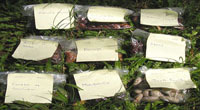 We often think of the rainforest as untouched by humans, or "virgin forest." In reality, it can be understood as the garden of the ancient Maya: the product of millennia of management by forest gardeners who cultivated the cycle of milpa, forest garden, and forest. In fact, 90% of plants in the forest are useful to humans, indicating considerable human influence. The Maya Forest remains the second most biodiverse place in the world (the Amazon forest is the first). The legacy of the ancient Maya forest gardeners is continued by the Maya farmers of the El Pilar Forest Garden Network.
We often think of the rainforest as untouched by humans, or "virgin forest." In reality, it can be understood as the garden of the ancient Maya: the product of millennia of management by forest gardeners who cultivated the cycle of milpa, forest garden, and forest. In fact, 90% of plants in the forest are useful to humans, indicating considerable human influence. The Maya Forest remains the second most biodiverse place in the world (the Amazon forest is the first). The legacy of the ancient Maya forest gardeners is continued by the Maya farmers of the El Pilar Forest Garden Network.
seeds collected to be planted the following year
 Alfonso Tzul, a modern Maya farmer and retired agricultural extension officer, describes how forest gardens came to be: "God created plants and animals and the world around us. Trees grew in the forest, seeds spread, birds sang, and animals flourished. All was already there. Man came along and preferred this plant, favored that seed, enjoyed those birds, and supported those animals, creating and using the forest as a garden to sustain those plants and animals. The job of the forest gardener is to manage the forest by adding, removing and nurturing plants, to make sure that certain species grow where they will be most viable."
Alfonso Tzul, a modern Maya farmer and retired agricultural extension officer, describes how forest gardens came to be: "God created plants and animals and the world around us. Trees grew in the forest, seeds spread, birds sang, and animals flourished. All was already there. Man came along and preferred this plant, favored that seed, enjoyed those birds, and supported those animals, creating and using the forest as a garden to sustain those plants and animals. The job of the forest gardener is to manage the forest by adding, removing and nurturing plants, to make sure that certain species grow where they will be most viable."
Alfonzo Tzul amidst his plantain grove
A forest garden is an unplowed, tree-dominated agricultural field that is cultivated year-round. Requiring skill and knowledge to cultivate, it sustains biodiversity and animal habitat while producing plants to meet a diverse array of human needs, like food, shelter, medicine, and many others. It is almost entirely maintained with local resources, such as household refuse (compost), organic material (dead weeds), ashes from kitchen fires, and manure, all of which enrich the soil and productivity of the land without the use of chemically manufactured additives like pesticides or fertilizers. The forest garden is part of the traditional Maya land management system known as the milpa-forest garden cycle, or simply the milpa cycle.
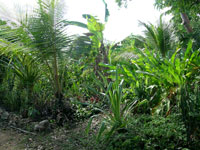 Maya forest gardens are the most diverse domestic cultivation systems in the world. In 19 forest gardens, researchers working with the El Pilar Forest Garden Network found approximately 370 different species of plants cultivated by the forest gardeners (see our plant database). Forest gardeners cultivate diversity because of their rich traditional knowledge of plant use. They nurture plants for food, medicine, spices, dyes, ornaments, construction, household products, toys, beverages, rituals, fodder, and more.
Maya forest gardens are the most diverse domestic cultivation systems in the world. In 19 forest gardens, researchers working with the El Pilar Forest Garden Network found approximately 370 different species of plants cultivated by the forest gardeners (see our plant database). Forest gardeners cultivate diversity because of their rich traditional knowledge of plant use. They nurture plants for food, medicine, spices, dyes, ornaments, construction, household products, toys, beverages, rituals, fodder, and more.
how many different plants can you count? Maya forest gardens are the most biodiverse domestic systems in the world.
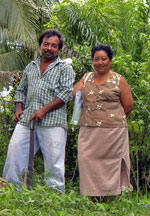 Forest gardening is a model for sustainable agriculture in the tropical forest that advantages the local ecosystem. These traditional farmers practice sustainable, local, organic agriculture, cultivating an array of crops year-round in a polycultivation, permaculture system. In the forest, they encourage biodiversity by nurturing plants and harvesting sustainably. They depend on the local economy by buying and selling in nearby markets, and hiring local labor. To top it off, their yields are comparable to those of industrial farmers.
Forest gardening is a model for sustainable agriculture in the tropical forest that advantages the local ecosystem. These traditional farmers practice sustainable, local, organic agriculture, cultivating an array of crops year-round in a polycultivation, permaculture system. In the forest, they encourage biodiversity by nurturing plants and harvesting sustainably. They depend on the local economy by buying and selling in nearby markets, and hiring local labor. To top it off, their yields are comparable to those of industrial farmers.
Forest gardener Carmen Cruz with his wife Betty in their forest garden
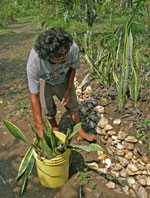 In their words, a forest gardener is someone who takes care of the plants and animals of the forest, as well as promotes the forestís biodiversity, while at the same time providing for their families. They do this by cultivating a diverse forest garden and milpa that includes food for the animals and insects.
In their words, a forest gardener is someone who takes care of the plants and animals of the forest, as well as promotes the forestís biodiversity, while at the same time providing for their families. They do this by cultivating a diverse forest garden and milpa that includes food for the animals and insects.
There is no typical forest gardener. Some focus on medicinal plants, others on food plants, others on ornamentals, and still others on trees for construction. The possibilities are endless, but the essential idea remains: that the forest can be inhabited and managed by humans while promoting growth, prosperity, and diversity.
Forest gardener Lucas Medina planting ornamentals
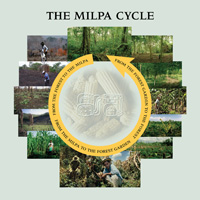 The milpa cycle is the conservation method of farming and managing the Maya forest. It goes through four main stages over the course of approximately 20 years: from the forest to the milpa; from the milpa to the forest garden; and from the forest garden back to the forest.
The milpa cycle is the conservation method of farming and managing the Maya forest. It goes through four main stages over the course of approximately 20 years: from the forest to the milpa; from the milpa to the forest garden; and from the forest garden back to the forest.
The traditional milpa and forest garden is an unplowed, multi-crop field that sustains biodiversity and animal habitat while producing plants for food, spice, shelter, medicine, ornament and profit. It can be fertilized by household refuse (compost), organic material (dead weeds), ashes from kitchen fires, and manure, enriching the soil and increasing productivity without the use of chemically manufactured fertilizer.
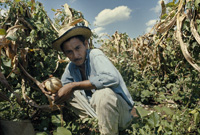 STAGE 1: From the Forest to the Milpa
STAGE 1: From the Forest to the Milpa
In the first stage of the milpa, a piece of forest is cleared of trees, and then burned to prepare for planting. For the first two to three years the Mesoamerican trilogy of maize, beans, and squash are cultivated in the full sun. Amidst this low canopy of maize is a dynamic ecology of herbs, tubers, and other plants that we might consider weeds, but are actually cultivated by the forest gardener to detract pests from the main crops, enhance the soil with nutrients, and help maintain moisture in the ground.
 STAGE 2: From the Milpa to the Forest Garden
STAGE 2: From the Milpa to the Forest Garden
In the second stage, the milpa evolves into the forest garden. Quick-yielding fruit trees, like plantain, banana, and papaya, are planted and begin to produce within a year. Fruit trees that need more time to produce, such as avocado, mango, citrus, allspice, guava, cherimoya, ramón, and others are planted amidst the maize, beans, and squash to bear fruit in five years.
 STAGE 3: From the Forest Garden to the Forest
STAGE 3: From the Forest Garden to the Forest
In the third stage, the fruit trees mature and begin to produce. The fruit trees provide a new canopy, blocking the sun and inhibiting undergrowth. Maize, beans, and squash are no longer viable in the shade. Amidst the fruit tree canopy, hardwoods, such as cedar and mahogany, are planted to mature over the next decades.
 STAGE 4: Forest Regeneration
STAGE 4: Forest Regeneration
In stage four of the milpa cycle; the forest garden is transformed into a hardwood forest. The hardwoods rise above the fruit trees to create a high canopy. The milpa has now regenerated to look much like it did before the forest gardener cleared and burned it two decades earlier. It is now a managed forest with little to no undergrowth. The forest gardener will let the hardwood trees grow and mature. He or she can harvest the trees for personal use or sell them when they again clear, burn, and plant the field. The cycle of the milpa begins again.
Image credits: Macduff Everton
Industrial Agriculture and the Developing World
The modern industrial approach to agriculture focuses on the mechanized production of monoculture crops, particularly the hybrid seed varieties of commodity crops like maize, wheat, rice, and soybeans. The idea is to increase efficiency by eliminating the need for human labor with machines, and increase yields of staple grains with chemical inputs (fertilizers, pesticides, etc).
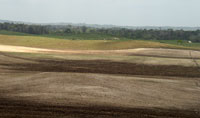 Monoculture cultivation, a hallmark of industrial farming, requires chemical fertilizers and pesticides, costing subsistence farmers money, polluting water sources, killing beneficial insects, and ultimately winding up in our bodies when we consume these crops in the form of industrial processed food, or meat from livestock animals that were fed these crops.
Monoculture cultivation, a hallmark of industrial farming, requires chemical fertilizers and pesticides, costing subsistence farmers money, polluting water sources, killing beneficial insects, and ultimately winding up in our bodies when we consume these crops in the form of industrial processed food, or meat from livestock animals that were fed these crops.
A plowed field in the Maya region. Note the white cattle grazing in the background, as well as the high forest at the horizon. This field was once as forested as the horizon.
Although this approach was designed for the American Midwest, it has been promoted world wide for developing nations by the international development agenda, including the Food and Agriculture Organization of the United Nations (FAO) and the World Bank, in what is known as the Green Revolution.
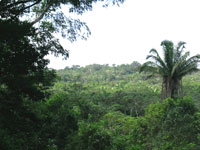 International development institutions believed in the promise of their model for agricultural modernization. One objective of the model is to increase exports of commodity crops. The climate, soils, government subsidies, and infrastructure, however, of the American Corn Belt for which industrial farming is designed, differ vastly from much of the developing world. This has led to significant environmental, economic, and cultural damage throughout the developing world, including the Maya Forest. Some areas, such as Spanish Lookout in the Cayo district of Belize, have been completely transformed by pasture and plow.
International development institutions believed in the promise of their model for agricultural modernization. One objective of the model is to increase exports of commodity crops. The climate, soils, government subsidies, and infrastructure, however, of the American Corn Belt for which industrial farming is designed, differ vastly from much of the developing world. This has led to significant environmental, economic, and cultural damage throughout the developing world, including the Maya Forest. Some areas, such as Spanish Lookout in the Cayo district of Belize, have been completely transformed by pasture and plow.
The high forest canopy
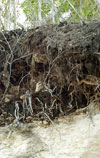 The practice of industrial agriculture is incompatible with the landscape of the Maya Forest. Consequently, it is causing environmental and cultural harm in the Maya region. Mechanized farming is not suitable for its soil or ecology. It requires a focus on single commodity crops in maintained field clearings. As the Maya region sits on a limestone plateau, plant cover is critical to retain water. When cleared, the limestone acts like a sponge leaving no water on the surface. Moreover, the best cultivable soil is in the hills and ridges of the region, typically ~20 cm, or 8-10 inches, thick: they are ill suited for the plow.
The practice of industrial agriculture is incompatible with the landscape of the Maya Forest. Consequently, it is causing environmental and cultural harm in the Maya region. Mechanized farming is not suitable for its soil or ecology. It requires a focus on single commodity crops in maintained field clearings. As the Maya region sits on a limestone plateau, plant cover is critical to retain water. When cleared, the limestone acts like a sponge leaving no water on the surface. Moreover, the best cultivable soil is in the hills and ridges of the region, typically ~20 cm, or 8-10 inches, thick: they are ill suited for the plow.
the thin soil layer resting on the white limestone plateau on which the Maya Forest rests, visible from a road cut. Notice the root systems, which help prevent erosion.
 While there is no development policy in Belize, the Lands Department calls land "developed" when it has been cleared. Traditional farmers therefore face the threat of loosing their farmland to the government because traditional multi-crop cultivation is not recognized as development. How can that be?
While there is no development policy in Belize, the Lands Department calls land "developed" when it has been cleared. Traditional farmers therefore face the threat of loosing their farmland to the government because traditional multi-crop cultivation is not recognized as development. How can that be?
monoculture cultivation of maize in Spanish Lookout, Belize.
 Because a traditional field is rarely cleared yet it is always producing. To the uninitiated eye, it resembles the forest. This is why it is called the Maya forest garden.
Because a traditional field is rarely cleared yet it is always producing. To the uninitiated eye, it resembles the forest. This is why it is called the Maya forest garden.
The polyculture field of a forest gardener where maize, bananas, hardwoods, tomatoes, beans, herbs, moxan, and other plants are being cultivated together.
Show all the sections at once! Such as to print this page
Copyright © 2007 - 20011 El Pilar Maya Forest Garden Network.
All Rights Reserved

 We often think of the rainforest as untouched by humans, or "virgin forest." In reality, it can be understood as the garden of the ancient Maya: the product of millennia of management by forest gardeners who cultivated the cycle of milpa, forest garden, and forest. In fact, 90% of plants in the forest are useful to humans, indicating considerable human influence. The Maya Forest remains the second most biodiverse place in the world (the Amazon forest is the first). The legacy of the ancient Maya forest gardeners is continued by the Maya farmers of the El Pilar Forest Garden Network.
We often think of the rainforest as untouched by humans, or "virgin forest." In reality, it can be understood as the garden of the ancient Maya: the product of millennia of management by forest gardeners who cultivated the cycle of milpa, forest garden, and forest. In fact, 90% of plants in the forest are useful to humans, indicating considerable human influence. The Maya Forest remains the second most biodiverse place in the world (the Amazon forest is the first). The legacy of the ancient Maya forest gardeners is continued by the Maya farmers of the El Pilar Forest Garden Network. Alfonso Tzul, a modern Maya farmer and retired agricultural extension officer, describes how forest gardens came to be: "God created plants and animals and the world around us. Trees grew in the forest, seeds spread, birds sang, and animals flourished. All was already there. Man came along and preferred this plant, favored that seed, enjoyed those birds, and supported those animals, creating and using the forest as a garden to sustain those plants and animals. The job of the forest gardener is to manage the forest by adding, removing and nurturing plants, to make sure that certain species grow where they will be most viable."
Alfonso Tzul, a modern Maya farmer and retired agricultural extension officer, describes how forest gardens came to be: "God created plants and animals and the world around us. Trees grew in the forest, seeds spread, birds sang, and animals flourished. All was already there. Man came along and preferred this plant, favored that seed, enjoyed those birds, and supported those animals, creating and using the forest as a garden to sustain those plants and animals. The job of the forest gardener is to manage the forest by adding, removing and nurturing plants, to make sure that certain species grow where they will be most viable."  Maya forest gardens are the most diverse domestic cultivation systems in the world. In 19 forest gardens, researchers working with the El Pilar Forest Garden Network found approximately 370 different species of plants cultivated by the forest gardeners (see our
Maya forest gardens are the most diverse domestic cultivation systems in the world. In 19 forest gardens, researchers working with the El Pilar Forest Garden Network found approximately 370 different species of plants cultivated by the forest gardeners (see our  Forest gardening is a model for sustainable agriculture in the tropical forest that advantages the local ecosystem. These traditional farmers practice sustainable, local, organic agriculture, cultivating an array of crops year-round in a polycultivation, permaculture system. In the forest, they encourage biodiversity by nurturing plants and harvesting sustainably. They depend on the local economy by buying and selling in nearby markets, and hiring local labor. To top it off, their yields are comparable to those of industrial farmers.
Forest gardening is a model for sustainable agriculture in the tropical forest that advantages the local ecosystem. These traditional farmers practice sustainable, local, organic agriculture, cultivating an array of crops year-round in a polycultivation, permaculture system. In the forest, they encourage biodiversity by nurturing plants and harvesting sustainably. They depend on the local economy by buying and selling in nearby markets, and hiring local labor. To top it off, their yields are comparable to those of industrial farmers. In their words, a forest gardener is someone who takes care of the plants and animals of the forest, as well as promotes the forestís biodiversity, while at the same time providing for their families. They do this by cultivating a diverse forest garden and milpa that includes food for the animals and insects.
In their words, a forest gardener is someone who takes care of the plants and animals of the forest, as well as promotes the forestís biodiversity, while at the same time providing for their families. They do this by cultivating a diverse forest garden and milpa that includes food for the animals and insects.




 Monoculture cultivation, a hallmark of industrial farming, requires chemical fertilizers and pesticides, costing subsistence farmers money, polluting water sources, killing beneficial insects, and ultimately winding up in our bodies when we consume these crops in the form of industrial processed food, or meat from livestock animals that were fed these crops.
Monoculture cultivation, a hallmark of industrial farming, requires chemical fertilizers and pesticides, costing subsistence farmers money, polluting water sources, killing beneficial insects, and ultimately winding up in our bodies when we consume these crops in the form of industrial processed food, or meat from livestock animals that were fed these crops. International development institutions believed in the promise of their model for agricultural modernization. One objective of the model is to increase exports of commodity crops. The climate, soils, government subsidies, and infrastructure, however, of the American Corn Belt for which industrial farming is designed, differ vastly from much of the developing world. This has led to significant environmental, economic, and cultural damage throughout the developing world, including the Maya Forest. Some areas, such as Spanish Lookout in the Cayo district of Belize, have been completely transformed by pasture and plow.
International development institutions believed in the promise of their model for agricultural modernization. One objective of the model is to increase exports of commodity crops. The climate, soils, government subsidies, and infrastructure, however, of the American Corn Belt for which industrial farming is designed, differ vastly from much of the developing world. This has led to significant environmental, economic, and cultural damage throughout the developing world, including the Maya Forest. Some areas, such as Spanish Lookout in the Cayo district of Belize, have been completely transformed by pasture and plow. The practice of industrial agriculture is incompatible with the landscape of the Maya Forest. Consequently, it is causing environmental and cultural harm in the Maya region. Mechanized farming is not suitable for its soil or ecology. It requires a focus on single commodity crops in maintained field clearings. As the Maya region sits on a limestone plateau, plant cover is critical to retain water. When cleared, the limestone acts like a sponge leaving no water on the surface. Moreover, the best cultivable soil is in the hills and ridges of the region, typically ~20 cm, or 8-10 inches, thick: they are ill suited for the plow.
The practice of industrial agriculture is incompatible with the landscape of the Maya Forest. Consequently, it is causing environmental and cultural harm in the Maya region. Mechanized farming is not suitable for its soil or ecology. It requires a focus on single commodity crops in maintained field clearings. As the Maya region sits on a limestone plateau, plant cover is critical to retain water. When cleared, the limestone acts like a sponge leaving no water on the surface. Moreover, the best cultivable soil is in the hills and ridges of the region, typically ~20 cm, or 8-10 inches, thick: they are ill suited for the plow. While there is no development policy in Belize, the Lands Department calls land "developed" when it has been cleared. Traditional farmers therefore face the threat of loosing their farmland to the government because traditional multi-crop cultivation is not recognized as development. How can that be?
While there is no development policy in Belize, the Lands Department calls land "developed" when it has been cleared. Traditional farmers therefore face the threat of loosing their farmland to the government because traditional multi-crop cultivation is not recognized as development. How can that be? Because a traditional field is rarely cleared yet it is always producing. To the uninitiated eye, it resembles the forest. This is why it is called the Maya forest garden.
Because a traditional field is rarely cleared yet it is always producing. To the uninitiated eye, it resembles the forest. This is why it is called the Maya forest garden.